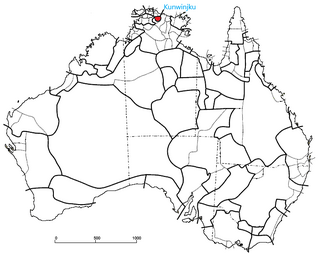The Pintupi are an Australian Aboriginal group who are part of the Western Desert cultural group and whose traditional land is in the area west of Lake Macdonald and Lake Mackay in Western Australia. These people moved into the Aboriginal communities of Papunya and Haasts Bluff in the west of the Northern Territory in the 1940s–1980s. The last Pintupi to leave their traditional lifestyle in the desert, in 1984, are a group known as the Pintupi Nine, also sometimes called the "lost tribe".

The Kunwinjku people are an Australian Aboriginal people, one of several groups within the Bininj people, who live around West Arnhem Land to the east of Darwin, Northern Territory. Kunwinjku people generally refer to themselves as "Bininj" in much the same way that Yolŋu people refer to themselves as "Yolŋu".
The Barungguan are an Aboriginal Australian people of the Cape York Peninsula of Northern Queensland. The name is associated with three languages: Ganganda, Umpithamu and Morrobolam.
The Unjadi (Unyadi) were an indigenous Australian people of the Cape York Peninsula of northern Queensland.
The Atjinuri were an indigenous Australian people of the Cape York Peninsula of Queensland.
The Miwa are an indigenous Australian people of the Kimberley region of Western Australia.
The Yeidji, also spelt Yiiji and other variants, commonly known as Gwini/ Kwini, are an Aboriginal Australian people of the Kimberley area of Western Australia, who also self-identify as Balanggarra.
The Ngardi, also spelled Ngarti, are an Aboriginal Australian people of the Northern Territory and Western Australia.
The Ngalia, or Ngalea, are an Aboriginal Australian people of the Western Desert cultural bloc resident in land extending from Western Australia to the west of South Australia. They are not to be confused with the Ngalia of the Northern Territory.

The Arabana, also known as the Ngarabana, are an Aboriginal Australian people of South Australia.
The Jabirr Jabbirr are an Indigenous Australian people of the Kimberley region of Western Australia.

The Nyulnyul, also spelt Nyul Nyul, Njolnjol, Nyolnyol and other variants, are an Aboriginal Australian people of the Kimberley region of Western Australia.
The Kuyani people, also written Guyani and other variants, and also known as the Nganitjidi, are an Aboriginal Australian people of the state of South Australia who speak the Kuyani language. Their traditional lands are to the west of the Flinders Ranges.
The Wailpi are an indigenous people of South Australia They are also known as the Adnyamathanha, which also refers to a larger group, though they speak a dialect of the Adnyamathanha language.
The Araba were an indigenous Australian people of Queensland.
The Laia were an indigenous Australian people of the state of Queensland.
The Yindjilandji are an indigenous Australian people of the Northern Territory.
The Luritja or Loritja people, also known as Kukatja or Kukatja-Luritja, are an Aboriginal Australian people of the Northern Territory. Their traditional lands are immediately west of the Derwent River, that forms a frontier with the Arrernte people, with their lands covering some 27,000 square kilometres (10,300 sq mi). Their language is the Luritja dialect, a Western Desert language.
The Yumu were an Indigenous Australian people of the Northern Territory.
The Gudanji, otherwise known as the Kotandji or Ngandji, are an indigenous Australian people of the Northern Territory.